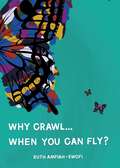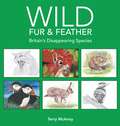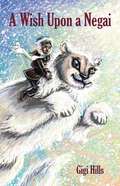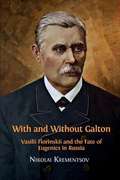- Table View
- List View
William Moorcroft, Potter: Individuality by Design
by Jonathan MallinsonWilliam Moorcroft (1872-1945) was one of the most celebrated potters of the early twentieth century. His career extended from the Arts and Crafts movement of the late Victorian age to the Austerity aesthetics of the Second World War. Rejecting mass production and patronised by Royalty, Moorcroft’s work was a synthesis of studio and factory, art and industry. He considered it his vocation to create an everyday art, both functional and decorative, affordable by more than a privileged few: ‘If only the people in the world would concentrate upon making all things beautiful, and if all people concentrated on developing the arts of Peace, what a world it might be,’ he wrote in a letter to his daughter in 1930.
William Moorcroft, Potter: Individuality by Design
by Jonathan MallinsonWilliam Moorcroft (1872-1945) was one of the most celebrated potters of the early twentieth century. His career extended from the Arts and Crafts movement of the late Victorian age to the Austerity aesthetics of the Second World War. Rejecting mass production and patronised by Royalty, Moorcroft’s work was a synthesis of studio and factory, art and industry. He considered it his vocation to create an everyday art, both functional and decorative, affordable by more than a privileged few: ‘If only the people in the world would concentrate upon making all things beautiful, and if all people concentrated on developing the arts of Peace, what a world it might be,’ he wrote in a letter to his daughter in 1930.
With and Without Galton: Vasilii Florinskii And The Fate Of Eugenics In Russia
by Nikolai KrementsovIn 1865, British polymath Francis Galton published his initial thoughts about the scientific field that would become ‘eugenics.’ The same year, Russian physician Vasilii Florinskii addressed similar issues in a sizeable treatise, entitled Human Perfection and Degeneration. Initially unheralded, Florinskii’s book would go on to have a remarkable afterlife in twentieth- and twenty-first-century Russia. In this lucid and insightful work, Nikolai Krementsov argues that the concept of eugenics brings together ideas, values, practices, and fears energised by a focus on the future. It has proven so seductive to different groups over time because it provides a way to grapple with fundamental existential questions of human nature and destiny. With and Without Galton develops this argument by tracing the life-story of Florinskii’s monograph from its uncelebrated arrival amid the Russian empire’s Great Reforms, to its reissue after the Bolshevik Revolution, its decline under Stalinism, and its subsequent resurgence: first, as a founding document of medical genetics, and most recently, as a manifesto for nationalists and racial purists. Krementsov’s meticulously researched ‘biography of a book’ sheds light not only on the peculiar fate of eugenics in Russia, but also on its convoluted transnational history, elucidating the field’s protean nature and its continuing and contested appeal to diverse audiences, multiple local trajectories, and global trends. It is required reading for historians of eugenics, science, medicine, education, literature, and Russia, and it will also appeal to the general reader looking for a deeper understanding of this challenging subject. Victoria College, University of Toronto, has generously contributed to the publication of this volume.
With and Without Galton: Vasilii Florinskii and the Fate of Eugenics in Russia
by Nikolai KrementsovIn 1865, British polymath Francis Galton published his initial thoughts about the scientific field that would become ‘eugenics.’ The same year, Russian physician Vasilii Florinskii addressed similar issues in a sizeable treatise, entitled Human Perfection and Degeneration. Initially unheralded, Florinskii’s book would go on to have a remarkable afterlife in twentieth- and twenty-first-century Russia. <p><p> In this lucid and insightful work, Nikolai Krementsov argues that the concept of eugenics brings together ideas, values, practices, and fears energised by a focus on the future. It has proven so seductive to different groups over time because it provides a way to grapple with fundamental existential questions of human nature and destiny. With and Without Galton develops this argument by tracing the life-story of Florinskii’s monograph from its uncelebrated arrival amid the Russian empire’s Great Reforms, to its reissue after the Bolshevik Revolution, its decline under Stalinism, and its subsequent resurgence: first, as a founding document of medical genetics, and most recently, as a manifesto for nationalists and racial purists. <p> Krementsov’s meticulously researched ‘biography of a book’ sheds light not only on the peculiar fate of eugenics in Russia, but also on its convoluted transnational history, elucidating the field’s protean nature and its continuing and contested appeal to diverse audiences, multiple local trajectories, and global trends. It is required reading for historians of eugenics, science, medicine, education, literature, and Russia, and it will also appeal to the general reader looking for a deeper understanding of this challenging subject.
Without Trace: An Utterly Gripping Detective Crime Thriller With An Unexpected Twist (Di Geraldine Steel Ser. #20)
by Leigh RussellWoodstock Scholarship: An Interdisciplinary Annotated Bibliography
by Jeffrey N. GattenSince August 1969, the Woodstock Music and Art Fair looms large when recounting the history and impact of the baby boom generation and the societal upheavals of the Sixties. Scholars study the sociological, political, musical, and artistic impact of the event and use it as a cultural touchstone when exploring alternative perspectives or seeking clarity. This interdisciplinary annotated bibliography records the details of over 400 English-language resources on the Festival, including books, chapters, articles, websites, transcriptions and videos. Divided into six main subsections―Culture & Society, History, Biography, Music, Film, Arts & Literature―for ease of consultation Woodstock Scholarship sheds light on all facets of a key happening in our collective history. Throughout the 1960s, popular music became increasingly reflective and suggestive of the rising political and social consciousness of the youth culture. Examples can be seen in the development of the protest song genre within the folk music boom of the early Sixties and the marriage of lifestyle to music first reflected by The Beatles with fashion, followed by psychedelic music with the emerging drug culture. Woodstock was where these themes coalesced, thus becoming the defining and last great moment of the 1960s. However, Woodstock also represented an abundant amount of experiences and ideas and moments. Thus, when exploring the complicated accounts and numerous facets of America during the turbulent Sixties one discovers scholarship on the key subjects, such as the Vietnam War or the Civil Rights Movement, often considering and debating the importance, relevance, and epic nature of Woodstock. Multiple narratives emerge: a radical engagement of the hippie movement, an overt commercial exploitation of youth culture, a political statement. Woodstock scholarship does not stand alone as field of study, but it is at the cross-road of a number of disciplines―music history, cultural studies, sociology, arts and literature, media studies, politics and economics. Providing full bibliographical details and concise, informative annotation for each entry, Woodstock Scholarship is an essential tool for students, scholars, teachers, and librarians in all these areas, as well as for anyone seeking a deeper understanding of both the Woodstock Music and Art Fair phenomenon and of the confluence of music, commerce and politics.
Zombies in Western Culture: A Twenty-first Century Crisis
by John Vervaeke Christopher Mastropietro Filip MiscevicWhy has the zombie become such a pervasive figure in twenty-first-century popular culture? John Vervaeke, Christopher Mastropietro and Filip Miscevic seek to answer this question by arguing that particular aspects of the zombie, common to a variety of media forms, a crisis in modern Western culture. The authors examine the essential features of the zombie, including mindlessness, ugliness and homelessness, and argue that these reflect the outlook of the contemporary West and its attendant zeitgeists of anxiety, alienation, disconnection and disenfranchisement. They trace the relationship between zombies and the theme of secular apocalypse, demonstrating that the zombie draws its power from being a perversion of the Christian mythos of death and resurrection. Symbolic of a lost Christian worldview, the zombie represents a world that can no longer explain itself, nor provide us with instructions for how to live within it. The concept of 'domicide' or the destruction of home is developed to describe the modern crisis of meaning that the zombie both represents and reflects. This is illustrated using case studies including the relocation of the Anishinaabe of the Grassy Narrows First Nation, and the upheaval of population displacement in the Hellenistic period. Finally, the authors invoke and reformulate symbols of the four horseman of the apocalypse as rhetorical analogues to frame those aspects of contemporary collapse that elucidate the horror of the zombie. Zombies in Western Culture: A Twenty-First Century Crisis is required reading for anyone interested in the phenomenon of zombies in contemporary culture. It will also be of interest to an interdisciplinary audience including students and scholars of culture studies, semiotics, philosophy, religious studies, eschatology, anthropology, Jungian studies, and sociology.
Zoonosi e sanità pubblica: Un approccio interdisciplinare per un problema emergente
by F. CanavesiLe zoonosi, cioè le infezioni naturalmente trasmissibili tra le altre specie animali e l'uomo, costituiscono oggi, anche nei paesi sviluppati, un problema emergente. Mutamenti climatici, flussi migratori umani, crescita degli scambi internazionali e guerre favoriscono sia il riemergere di malattie considerate rare, sia l'introduzione in nuove aree geografiche di organismi potenzialmente patogeni. Per buona parte di queste patologie, tuttavia, la maggioranza degli operatori sanitari - a cominciare dai medici di medicina generale - spesso non dispone di conoscenze e strumenti appropriati e aggiornati. Il testo si propone di fornire al personale medico - e in primo luogo ai medici di medicina generale - sia un quadro di riferimento scientifico e normativo, sia una serie di informazioni specifiche e pratiche sulle singole patologie. Questo volume vuole essere uno strumento operativo volto anche a favorire la collaborazione multidisciplinare e lo scambio di informazioni, in particolare tra medici e veterinari.







